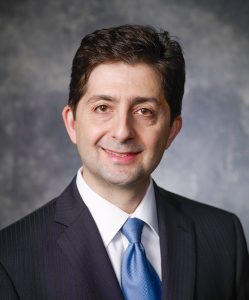 Electrical engineering expert Dr. Aria Nosratinia focuses his research on reducing interference in radio channels in order to improve wireless communication. Reducing interference, he says, is especially critical now that more devices are connected to the Internet of Things and crowding the wireless spectrum. The National Science Foundation recently awarded his lab at the University of Texas at Dallas $2.2 million in grants to support this work. In an email exchange with In Compliance editors, Nosratinia described several areas of his research. We include his note here, lightly edited for clarity.
Electrical engineering expert Dr. Aria Nosratinia focuses his research on reducing interference in radio channels in order to improve wireless communication. Reducing interference, he says, is especially critical now that more devices are connected to the Internet of Things and crowding the wireless spectrum. The National Science Foundation recently awarded his lab at the University of Texas at Dallas $2.2 million in grants to support this work. In an email exchange with In Compliance editors, Nosratinia described several areas of his research. We include his note here, lightly edited for clarity.
We are well known for early contributions to cooperative communication, where an intermediate node assists in the operation of a physical layer link. This is distinct from multi-hop radio in the sense that multiple nodes are involved in the establishment of one physical layer radio link. Cooperative communication reduces the emitted power for a given bitrate transmission, thus reduces the interference temperature. Our early work in this area has received thousands of citations. Cooperative communication is related to the Coordinated MultiPoint (CoMP) technology that is now part of the LTE Advance cellular standard.
We have also produced ground breaking work in the area of cognitive radio and spectrum sharing, a method where parts of licensed spectrum that are unused at certain locations or times may be recycled and reused by a secondary link. The work in my lab for the first time clarified the theoretical underpinning of the interference implications of such technologies under multi-user diversity.
We also are known for some of the best structured LDPC codes in the literature. By improving the error immunity of the links, a good error control code allows the transmitter to emit lower power and yet achieve the same communication quality, thus reducing interference on nearby cells.
One of the projects at our lab explores the implications of a discovery made at UT Dallas, indicating that variations in the coherence interval of various links in the wireless channel, which naturally exist due to differences in speed or scattering environment, may be leveraged via new signaling schemes that reduce the interference between users in the downlink and achieve large gains in the capacity of multi-user communication systems.
Another project investigates the decomposition of wireless transmission signals into micro-streams in order to produce a more friendly interference profile and/or be more robust to interference. These signals are to be transmitted via liquid metal antennas that can be reconfigured to match the operating conditions and the interference climate.
